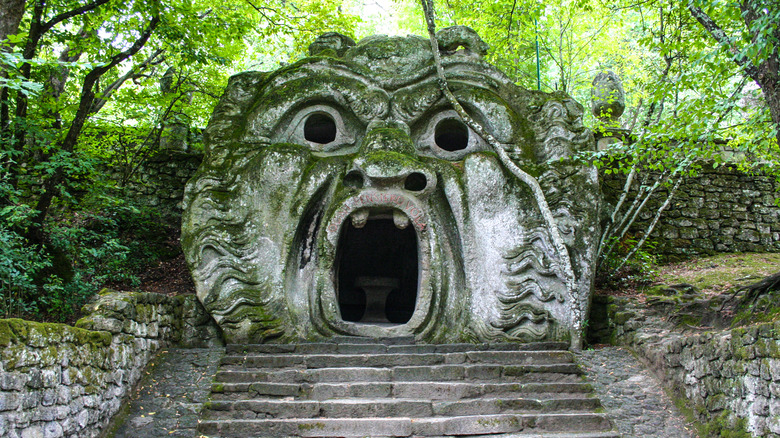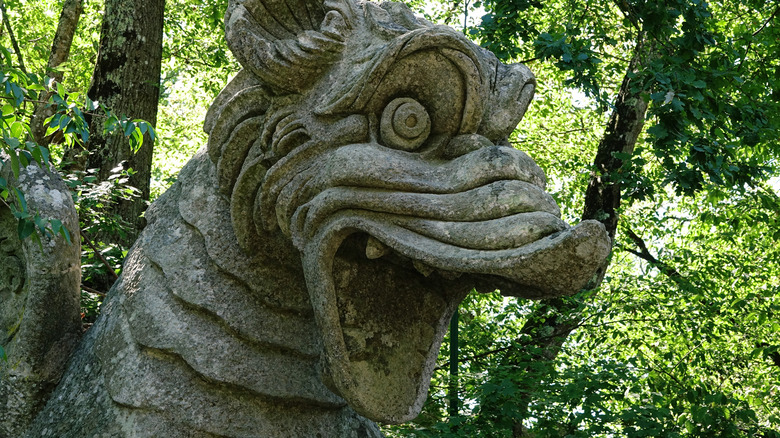Why You Should Never Walk Alone At Night Through Italy's Gardens Of Bomarzo
It's safe to say Europe is positively chock-a-block with beautiful gardens, with many dating back centuries or more. Unsurprisingly, those very gardens are a big draw for tourists. In France, for example, the lush and meticulous gardens of Versailles bring in roughly 10 million visitors per year. In the U.K., Blenheim Palace's regal parks were enough to have the estate declared a UNESCO World Heritage site in 1987. And in Italy, beautiful gardens blue-printed and created during the Renaissance can be found all across the peninsula (via The Guardian).
However, not every garden in Europe was built with the image of genteel aristocrats in mind. For some, at least one Italian botanical site could be thought of as less of a run-of-the-mill "garden" and more of a horror show writ large — well, at least when it was first built in the 16th century. By all accounts, this particular garden appeared to have been borne out of grief, by the person credited with its creation. The result was seemingly a collective visual representation of alarm and fear — all because the garden is filled with horrifying creatures carved out of stone.
This Italian garden is home to the 'monsters of Bomarzo'
The year 1552 was not a good one for Italian man-about-town Prince Pier Francesco Orsini, according to one write-up published by Atlas Obscura. He'd fought in a protracted war, during which he had been taken prisoner and held captive for years. When he finally made it home, his beloved wife, Giulia Farnese, died. Now grieving, the prince hired artist and architect Pirro Ligorio — who had worked on nothing less than Saint Peter's Basilica in Rome – to build a garden for him in Giulia's honor (via the BBC).
Per Atlas Obscura, the result was a mishmash of various stone sculptures in a park area known today as the Gardens of Bomarzo, after the town in which it's located. While another popular name for the area is Sacro Bosco (or "Sacred Forest"), it's also known by a few more sinister ones, like Parco dei Mostri ("Park of Monsters") or Bosco dei Mostri ("Forest of Monsters") — because a lot of the statuary there is downright horrifying (via the Italian Sons and Daughters of America). There's the pained grimace of a giant, through which visitors can walk through. There are furies, titans, and other mythological features. And then there's the fact that among the stone menagerie of creatures are ominous inscriptions for park visitors to read, like this one carved into a stone park bench: "You that are wandering through the world, willing to see high and splendid marvels, do come here where there are horrible faces, elephants, lions, bears, ogres and dragons."
Salvador Dali saved the Gardens of Bomarzo ... maybe
After Prince Pier Francesco Orsini died in 1583, the gardens fell into disrepair and ruin, and were forgotten about for the next several centuries, per the BBC. It wasn't until the mid-20th century that the gardens were rediscovered and restored — although there are varying accounts of how that happened and who was responsible for it.
According to Italian Sons and Daughters of America, a real estate agent named Giovanni Bettini was touring around Italy when he found the now moss-covered statues and decided to restore the gardens. (The website Traveling in Tuscany makes a similar claim that the Bettini family was responsible for restoring the garden.) However, both the BBC and Atlas Obscura note that surrealist artist Salvador Dalí (pictured above) had at least a hand in the salvation of the garden. Per both sources, the Spanish artist visited the Park of Monsters in the 1940s, fell in love with it, and used it as inspiration for both a painting and a film — all of which led to renewed interest in the site.
Today, you could say that the gardens are a shadow of what they were centuries ago, the monstrosities worn down by the elements. But in a way, those centuries of decay add their own layer of mystery to the ancient monuments — but the grief and horror trapped in stone will always remain.


